Antequera
Historical Outline
The history of Antequera goes back at least thousand years, to the era of the construction of the Menga, Viera and El Romeral dolmens. But even this is a conservative estimate if there is confirmation of the evidence found of earlier times in the excavations being carried out in the Cueva del toro (Bull´s cave) in the Sierra del Torcal mountain range. These prehistoric dolmens are very near to the town. Those of Menga and Viera are situated in an enclosure with gardens, next to the town itself along the Malaga-Granada road, the El Romeral dolmen is somewhat further away, on the road itself next to the sugar factory.
Evidence of Roman times is abundant. In the Giants' Arch (Arco de los Gigantes) there are various remains of the municipalities of Antikaria, Singilia and Nescania; in the Municipal Museum there are very interesting exhibits such as the "Ephebus of Antequera". There are also remains of the Arab Antakira, above all the castle dominating the town. The Moslem city suffered various sieges, but it was the lnfante don Ferdinand, called "of Antequera" who finally took it in 1410 after a hard, five-month-long siege.
With this event began the growth of Christian Antequera, which overflowed from the narrow walls of the Castle and spread over the flat land, giving rise to the present shape of the city with its important constructions of Renaissance and Baroque civil and religious buildings. It is above all this Baroque style which, together with the white fronts and cleanliness of the town's districts, give Antequera its character and transform it into one of the finest towns in Andalusia.
The victory over the Arabs was followed by years of hardship, until the Christian reconquest was strengthened by the taking of Málaga and Granada. The economic prosperity and religious faith of the town attracted various religious orders, and throughout the l6th, 17th and 18th centuries these orders raised magnificent churches, monasteries and convents, some outstanding examples of which are still standing. The families of those nobles who had taken part in the reconquest also settled in Antequera and built splendid town houses and mansions there.
The town
The present town is located to the north of the Sierra del Torcal mountains and stands on the left bank of the river Guadalhorce, which flows by the town and its splendid vale. It has a population of more than forty thousand inhabitants and is thus one of the main towns in the province of Málaga. Although very near Málaga and the Costa del Sol, the mountainous barrier of the Sierra del Torcal cuts it off from the coast and provides it with a cold climate in winter, and a hot, dry climate in summer.
Antequera lies in a particularly favoured geographical spot; it is only 46 km from Málaga and even nearer the main capitals of Andalusia (Córdoba, Seville and Granada). It thus has a very special relationship with these four cities and has become a real rural capital, where all farming, stock-raising and service activities meet together. In the past the town was an important industrial centre, manufacturing the famous “Antequera blanket” as well as producing other items such as hides. These activities have all but disappeared today, and are being revived in the industrial Estate, where development is slow but encouraging. However, the Christmas production of the famous butter buns, doughnuts and gingerbreads - which have made the name of Antequera known in many parts- is still going strong. The large amount of land given over to olives and cereals, plus other irrigation produces, constitute the main farming output.
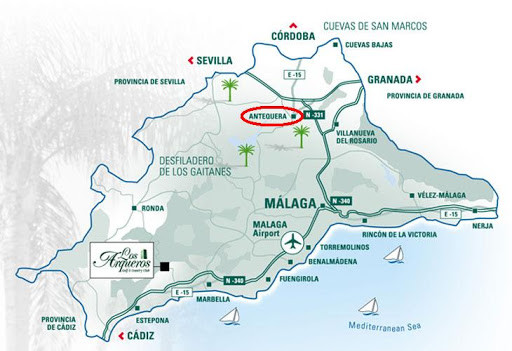
Main monuments
The Giants'Arch (Arco de los Gigantes, 1585) is an extremely interesting monument, raised with the highly original idea of covering its walls with a series of statues and slabs as witnesses to the grandeur of the town and other municipalities of the district in the times of the Romans. For this very reason it is regarded as the most important Roman antiquities museum in Spain. The 400th annivesary of the Arch was held in May 1985, with both slabs and statues being taken from the Municipal museum and replaced in their original positions.

Of the Arab Castle various walls and towers, such as the White Tower and the Keep, are still standing; the latter still has the legendary clock of Papabellotas. It is covered by a small Renaissance temple which houses the town's bell. All these buildings are set in the midst of an open park with gardens, from where are fine panoramic views of the town and its vale. Other monuments lie nearby, such as the Star Arch (Arco de la Estrella), the Water Arch (Arco del Agua), and the Málaga Gate (Puerta de Málaga) in the hermitage of the Virgin of Espera.
The Málaga Gate, or Hermitage of the Virgin of Espera, is situated in the lower part of the Castle and looks on to the town's river. In previous times it formed part of the second defence ring of the Alcazaba, and was linked to the White Tower by a series of walls (no longer standing). Its function was to provide communication between the walled inner enclosure and the outer one by means of an elegant brick horseshoe arch. Later the structure was greatly midifled when it came to be used as a hermitage. In the interior there is a small retable of the Virgin of Espera.
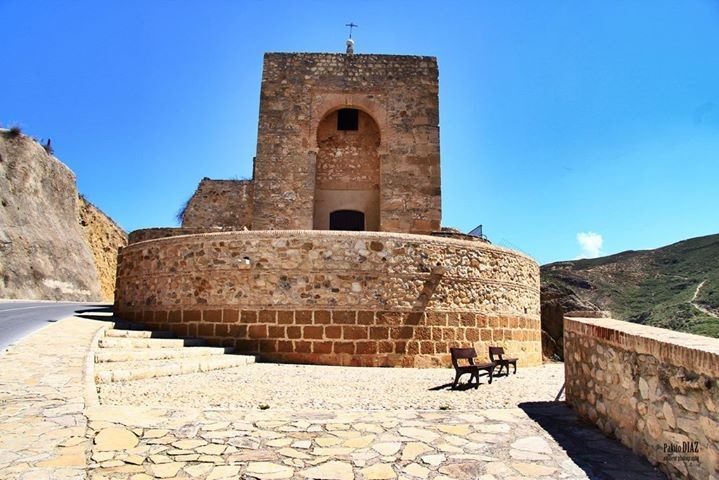
Municipal Museum
The museum is housed in the Palacio de Nájera, a fine 18th-century building with the most beautiful belvedere tower in Antequera on one of its corners. In the museum there are items of the greatest interest, such as the Antequera Ephebus, a striking 1st-century bronze sculpture. It was found by chance in some fields and depicts a nude adolescent. There is no doubt that it is “the finest piece of antiquity found in the Iberian peninsular”, and that it is worth making the trip to Antequera just to see it.

Another important archaeological find is the marble bust of Drusus the Greater; this is the portrait of a Roman prince of the first century. The various rooms of the Museum houses paintings, especially by Bocanegra, Mohedano, and the Mexican Juan Correa. There are also sixteen paintings by the Antequera artist Cristóbal Toral, one of the best contemporary painters. There are also various sculptures dotted around the Museum; one of the most striking is that of St. Francis of Assisi, the work ot the great image-maker Pedro de Mena. There is also an important collection of gold and silverwork, as well as related products such as Virgins' mantles, items belonging to the Holy Week Brotherhoods, retables, furniture and so on. In the basement there is a small collection of objects relating to folk customs. And as a grand finale there is an extremely important Archive section and a modern Library.
The Museum is open every morning of the week (Sundays included) except Monday morning.
Antequeras' churches
Seen from on high, Antequera is indeed a "city of spires", with the towers and bell-gables of the twenty or so churches rising above the town. Following are a few of the most important:
The Royal Collegiate Church of St. Mary the Greater was built between 1514 and 1550 and has been described as "the first Renaissance church built in Andalusia"; both its proportions and design are monumental. It has an interesting façade which, according to the experts, was re-created by Alonso Cano in Granada cathedral. It is divided into three axes and two bodies; the great half-point arch in the central doorway is fairly high and contrasts with the two side arches. Then comes blind balustrade, on top of which there is a triple pediment with fluted pinnacles. The large-proportioned interior has the ground-plan of a basilica; there is a central nave, side aisles, great Ionic-Renaissance columns and important Mudéjar coffering-work. The church has undergone very substantial restoration during the past few years and is now used as a venue for concerts and the like.
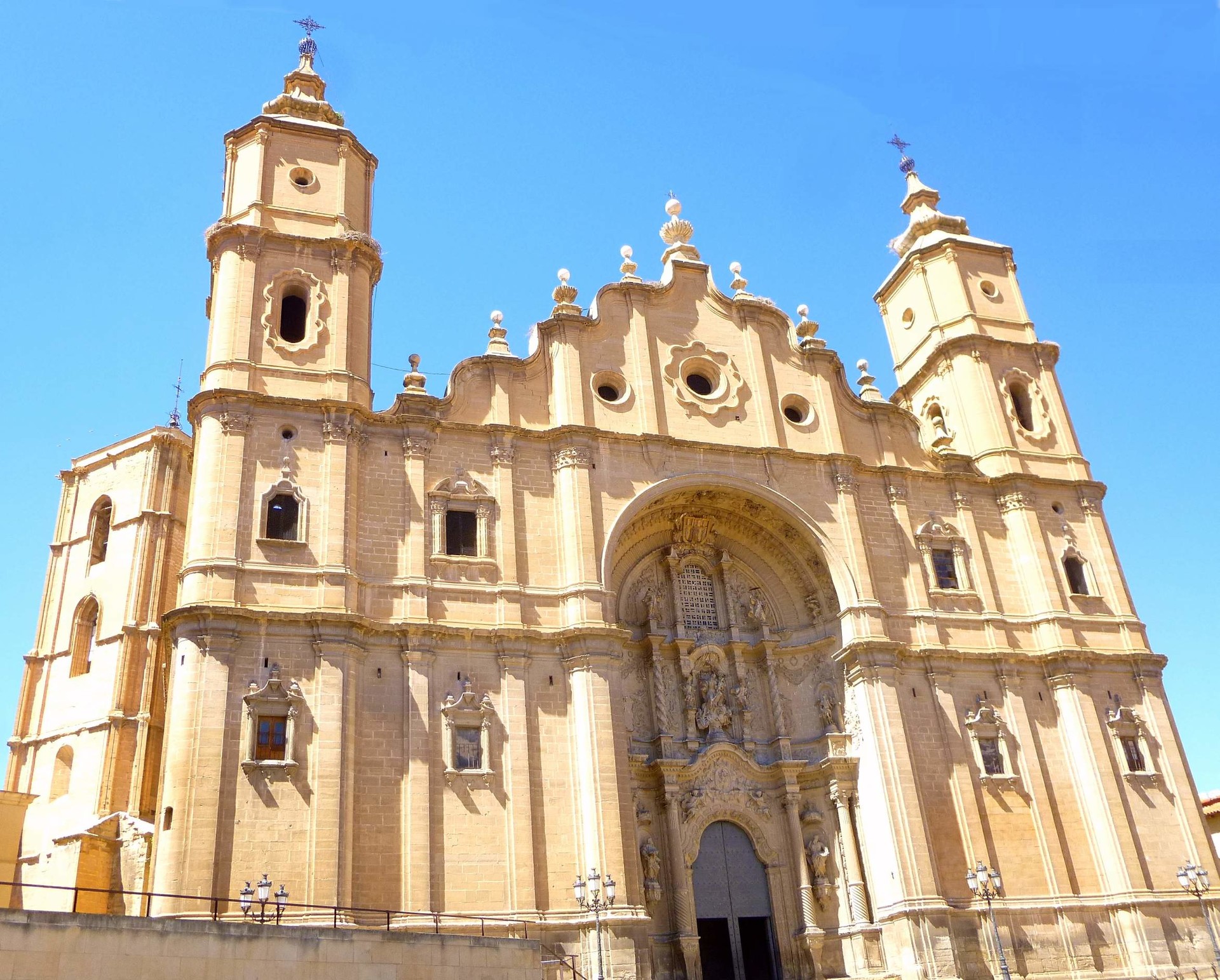
Church of El Carmen Although the building of this church (as well as the Monastery of the Discalced Carmelites, no longer standing) began towards the end of the 16th century, work continued for a good many years. There is a single nave with abutting side chapels. Points of interest are the splendid Mudéjar coffering (beginning of the 17th century) and the superb chancel with its three Baroque reredoses. The side ones are gilt and the central one, with its great proportions and plethora of columns, angels and saints covering every available inch of space, is done in ungilded wood and is "a fine example of Andalusian decadent Baroque, illnamed Churrigueresque".
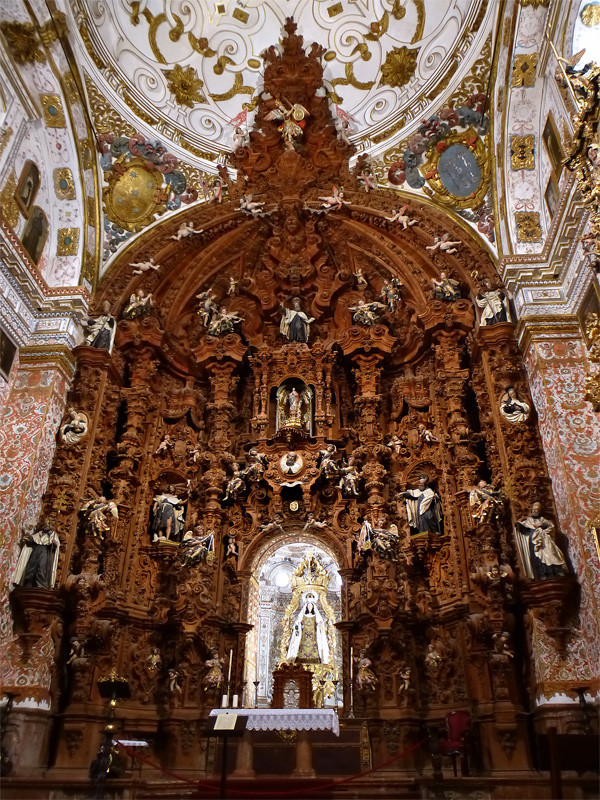
The Church of Our Lady of the Ransoms. This church stands beside the present-day Town Hall (previously a Franciscan monastery) and forms part of it. It dates from the 17th century, was long in the making, and has a Latin cross ground plan with side chapels. Practically the whole surface area of the church is covered by paintings of different kinds. Of interest is the intensely Baroque gilded high altar, built in the middle of the 18th century; it has various statues and the central alcove is occupied by the patron saint of Antequera, the Virgin of the Ransoms.
Collegiate church of St. Sebastian. The Collegiate church was transferred here from St. Mary's at the end of the 17th century. Of interest are its fully Renaissance façade and its fine Baroque brick tower decorated with terracotta, the work of Francisco Andrés Burgueño. The exterior of this church, together with the splendid Renaissance fountain in the square, the Arch of the nearby calle Nueva (New Street) and the Castle rising up in the background, form one of the prettiest sights in Antequera.
Other churches of interest Although they are well worth sections and detailed descriptions of their own, lack of space compels us simply to list the most interesting churches. There are: St. Francis´ (San Francisco), the Discalced Carmelites (Descalzas), Bethlehem (Belén), Mother of God (Madre de Dios), St. John of God (San Juan de Dios) amongst others. With their wealth of architecture and treasure of masterpieces inside, they are a monumental ensemble of the first rank.
Town houses and mansions
Although some of the most interesting have disappeared, many others, also important, are still standing. The mansion of the Marquis of la Peña is l6th-century. Belonging to the 17th century are the mansion of the Marquis of las Escalonias, the Municipal Palace and the Pardo House (Banco Hispano-Americano). Of the 18th century we have the Nájera Palace (Municipal Museum), the Pinofiel House, the House of the Count of Colchado, the Villadarias Palace, the Colarte House (House-Museum), and the House of the Baron of Sabasona. Belonging to the 20th century (more precisely the 1930´s) are the Serrailler House (by Aníbal González) the Antequera Saving Bank building, and the Torcal Cinema Theatre.
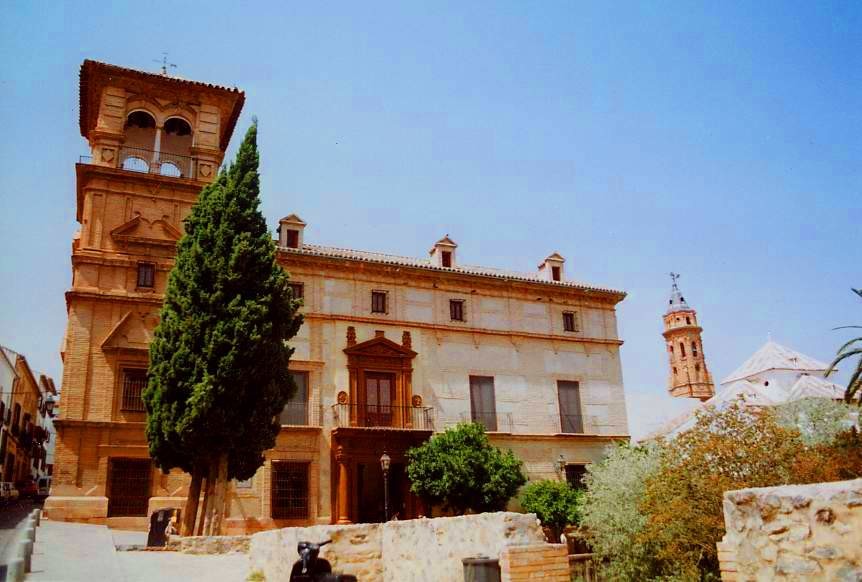
Palacio Nájera
The prehistoric dolmens
The (mis-named) "caves" of Menga, Viera and El Romeral are not far from the town. Together these "caves" from the most important group of dolmens in Europe, and are evidence of how, five thousand years ago, large townshipssettled in the fertile valley by the river Guadalhorce. They are examples offunerary constructions, raised with enormous stones and later covered over with earth, thus taking the shape of a slight promontory on the land. We shall deal with each one in greater detail:
The Menga dolmen. This is the largest and oldest of the three, and it is has been known since ancient times. It has been described as the "most majestic and best-conserved dolmen in the entire prehistoric world", and has been dated circa 2500 B. C. The oval-shaped chamber is 25 m long, has a maximum width of 6,5 m and is 2,7 m height. The dolmen begins with a (now incomplete) gallery leading to a large chamber with has seven large upright stones forming the sides, and an eight stone blocking the far end. The roof is made up of four enormous stones of great thickness and weight -the final one has been calculated as weighing some 180 tons. In the middle of the chamber there are three monolights which ostensibly are there to hold up the roof.

The Viera dolmen is very close to the Menga one and takes its name from the Viera brothers, municipal gardeners who discovered it in 1905. It is not as large as the Menga dolmen, and the careful dressing of the stone leads us to believe that there has been an architectural development between the two, which can be calculated as about 100 years ‘difference between the construction of the two dolmens. It has a long corridor leading to a cube shaped burial chamber of approximately 2m square. The stone at the end of this chamber was broken through at an unknown date by supposed “treasure hunters”.
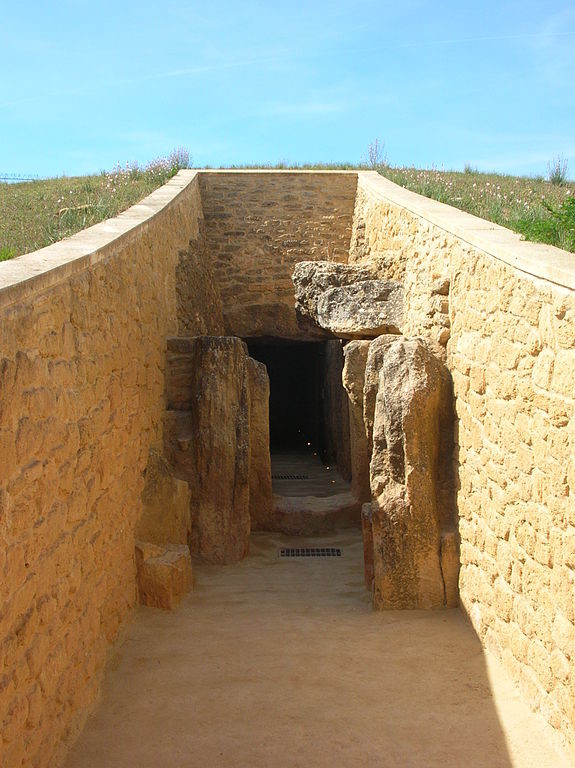
The El Romeral dolmen was also discovered by the Viera brothers in 1905. The point of great interest is that it has a circular burial chamber 5,2 m in diameter covered by a false –dome vault – the first example in Europe of this kind of construction which takes its inspiration from that of the Treasury of Atreus in Mycenae. Both the long access corridor and the burial chamber provide evidence of the development of building in time. The walls are constructed not with great slabs but with flat stone and mud filling. However, the stones and the roofs are still great in size. These and other points have to the construction being dated at circa 1800 B. C. There is another chamber linked to the great burial chamber by a small coridor. Although it has the same structure as the former, it is much smaller in size, with the altar for offerings' according to funerary rites.
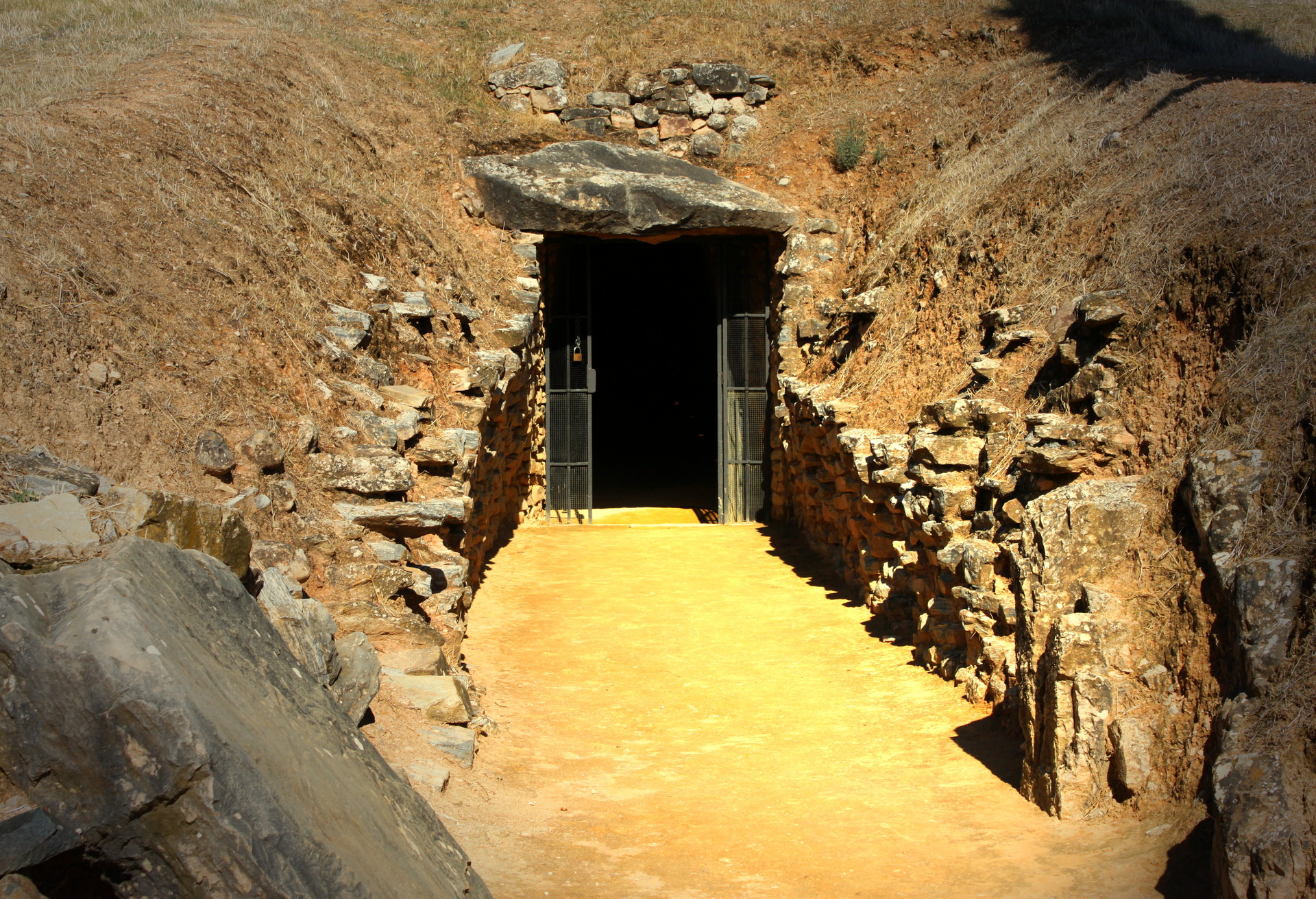
The legend of the lovers' rock
There is a small hillock on the boundary with Archidona, reminiscent of a mysterious sphinx due to its human-like shape. This hillock was dumb witness to the tragic end of the love affair between a young Christian from Antequera and a Moorish girl from Archidona. In view of the impossibility of consummating their love due to the hostile, antagonistic world surrounding them, they fled on horseback, with Moorish troops close on their heels, until they were surrounded at this Rock. Rather than surrender and be separated in this life, the young lovers chose to be united in the life beyond, and in loving embrace they hurled themselves over the precipice.

The Sierra del Torcal
Although the Sierra del Torcal mountain range has a total extension of some 30sq km, the Hight Torcal (where the best sights are to be had) only covers some 20 sq km. Access to this beautiful, description-defying spot is by means of a road running for some13 km, ending in a mountain refuge where there is a tavern. With peaks rising to over 1300 m, this is a very impressive carstic spot, where rainwater and other geological agents have shaped the rocky landscape, giving it a phantasmagorical look with shapes which conjure up things or beings – the ruins of a Pharaoh´s city, a city of Aztecs or Hindus, or else the ruined walls of a medieval castle, all in the midst of impressive silence, broken only by the song of the birds-

In 1929 this spot was declared a “Natural Site of National lnterest” and in 1978 a Natural Park. It is therefore protected from possible spoiling, and official organs have also set up a plan of action with regards to it. As to flora, there are few trees left, and these have been relegated to difficultly reached areas. However, there is an abundance of bushes such as thorn-bushes, sloe, honeysuckle and above all ivies, which embellish the great rocks with their enormous spreads.
There is an abundance of different classes of birds as well as reptiles, rabbits and the like, with a smaller number of mountain goats. Close by the mountain refuge there is a camp-fire and camping area as well as three routes which have been narked for hikers - green/yellow, yellow and red – each one of which takes longer to cover than the previous one. At a normal Pace each route would take 45 minutes, 2 hours and 3,5 hours to cover respectively. A very short trip could be made from the mountain refuge, along the unfinished road, to an area close to Las Ventanillas, from where the Mediterranean landscape can be appreciated on a clear day on the coast of Málaga.
Religious festivals
Hoty Week is celebrated in great solemnity, with processions full of character, wealth and tradition. The various splendid Virgins and the pained Christs are borne of the shoulders of the brethren whose place is handed down from grandfather to grandson. All these processions end in steep slopes which are raced up, bearings the very heavy thrones or platforms -a unique sight and characteristic of Antequera, given the name of "dar la venga".
On 16th September the conquest of the town is celebrated in the festival of Saint Euphemia. Bonfires, supposed to represent war scenes of those times, are lit on the previous night. Another festival held in September is the festival of the Virgin of Ransoms, the patron saint of Antequera. And finally, at the end of May de procession of the Lord of Health and Waters is held. This is an old-established religious event among the people of Antequera, and folk come from far afield to the annual meet in order to light the Lord.
Fair and other folk events
There are two annual fairs - the Spring Fair (31st May-2nd June) and the August Fair (20th-22nd August) – with bull-fights, various kinds of entertainments, attractions for the children, and fair stalls where singing and dancing go on into the early hours. These are times of rest from one's daily work, when people try to enjoy themselves as much as possible. Horses too have their place in the fairs; a great many riders parade with beautiful girls attired in typical dress sitting on the horse's hindquarters. In addition there are beautiful vintage carriages in the parades.
The Antequera fandango is a typical song and dance; it is undergoing considerable revival, as well as the typical dress. The latter has proliferated above all in the fairs of the past few years, and it is worn by a great many young people from Antequera in the parades of carriages and in the various places of entertainment, together with the traditional gypsy dress which is traditional in the whole of Andalusia.
On the occasion of children's festivals, the custom of killing the old lady persists. Here a curious rag dummy, stuffed with sweets and candies, is repeatedly raised and lowered at the end of a rope, until it is finally thwacked and pummelled to the ground by the children in an entertaining fight to get at the delicious contents.
Food and drink in Antequera
In Aritequera the visitor will find dishes which are typical of Andalusia, such as gazpacho, fried dishes and home-made sweets. The Antequera porra is to be singied out for special praise; it is made in the pestle and the ingredients are breadcrumbs, tomato and the delicious olive oil from the olive groves; the comes the pig's trotters stew in which there is a mixture of chickpeas, pig's trotters and other ingredients corning from the killing of the pig, all generously washed down with sherry.

La porra de Antequera
The town accords sherry full honours, and it is also served in bars and winebars accompanied by a wide variety of delicious snacks or tapas. Among the desserts we must mention the bienmesabe, a delicious sweet prepared by nuns, with strong Arab reminiscences, and made with almons, sugar and egg yolks as well as other secret ingredients – the recipe is kept a jealous secret by the chosen hand of the experts. In the Christmas season and the months leading up to it, the town smells heavenly, since in many places the typical Antequera butter bun (mantecado) is being made – in addition to other traditionally-made sweets as gingerbreads, polvorones, doughnuts and the like.
Excursions
Antequera, with its various hotel establishments and parador (state-run luxury hotel), is a centre from which various trips can be made, Seville, Córdoba and Granada are some two hours, drive away; Málaga and its Costa del Sol can be reached in only 45 minutes. Some 18 km along the Seville road there is Fuente Piedra with its famous lagoon, a spot of great ecological interest, since the largest colony of flamingoes in Spain nests there.
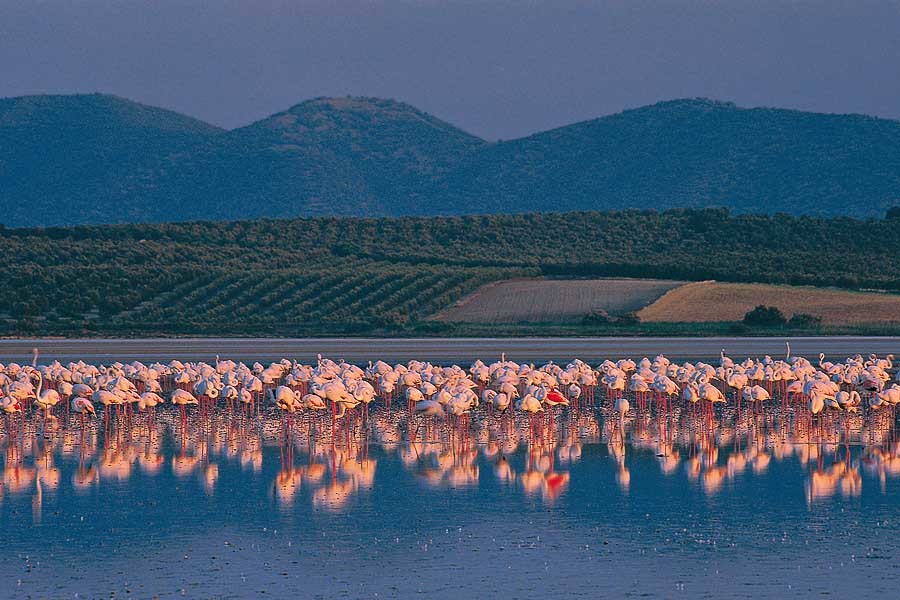
Photo gallery
Content available in other languages
- Español: Antequera
Want to have your own Erasmus blog?
If you are experiencing living abroad, you're an avid traveller or want to promote the city where you live... create your own blog and share your adventures!
I want to create my Erasmus blog! →






























Comments (0 comments)